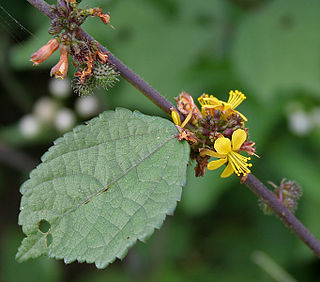
Bignonia is a genus of flowering plants in the family Bignoniaceae. Its genus and family were named after Jean-Paul Bignon by his protégé Joseph Pitton de Tournefort in 1694, and the genus was established as part of modern botanical nomenclature in 1753 by Carl Linnaeus. Species have been recorded from the southern USA, Central to most of South America.

Leptactina is a genus of flowering plants in the family Rubiaceae. There are about 27 species. They are all native to sub-Saharan Africa, where most occur in rainforest habitat.

Tricalysia is a genus of flowering plants in the family Rubiaceae. The genus is found in tropical and southern Africa and on the islands in the Western Indian Ocean.

Vangueria is a genus of flowering plants in the family Rubiaceae. The genus is named for Voa vanguer, as V. madagascariensis is known in Malagasy.

Corynanthe johimbe, synonym Pausinystalia johimbe, common name yohimbe, is a plant species in the family Rubiaceae native to western and central Africa. Extracts from yohimbe have been used in traditional medicine in West Africa as an aphrodisiac, called in some languages burantashi, and have been marketed in developed countries as dietary supplements.

Triumfetta is a genus of plants in the family Malvaceae. Burbark is a common name for plants in this genus.
Cuviera is a genus of flowering plants in the family Rubiaceae native to tropical Africa. It was originally described by Augustin Pyramus de Candolle in 1807 and is named after the French naturalist Georges Cuvier.

Markhamia is a genus of flowering plants in the family Bignoniaceae. The genus is named after Clements Markham.

Fockea is a genus of succulent scrubs native to Africa south of the equator. They are members of the Asclepiadoideae (milkweeds), a subfamily of the dogbane family Apocynaceae. Of the six recognized species, only the two most widely distributed extend north of southern Africa, with F. multiflora reaching as far north as Tanzania and F. angustifolia reaching to southern Kenya. Fockea are known as water roots, a reference to the bulbous caudex characteristic of most species, which is also edible in at least some species.
Octolobus is a genus of tropical forest trees in the family Malvaceae, subfamily Sterculioideae. They are found in Central and West Africa and are closely related to the genus Cola.
Schlechterella is a genus of plants in the family Apocynaceae. It is native to Africa, found in Ethiopia, Kenya, Mozambique, Somalia, Tanzania and Uganda.
Antiaropsis is a genus of flowering plants belonging to the family Moraceae. It is dioecious, with male and female flowers borne on separate plants.
Calycacanthus is a genus of flowering plants belonging to the family Acanthaceae.
Conandrium is a genus of flowering plants belonging to the family Primulaceae.
Harmsia is a genus of flowering plants belonging to the family Malvaceae.
Hedythyrsus is a genus of flowering plants belonging to the family Rubiaceae.

Leptonychia is a genus of flowering plants belonging to the family Malvaceae.
Lucya is a monotypic genus of flowering plants belonging to the family Rubiaceae. It only contains one known species, 'Lucya tetrandra'(L.) K.Schum.
Siphonandrium is a genus of flowering plants belonging to the family Rubiaceae.









